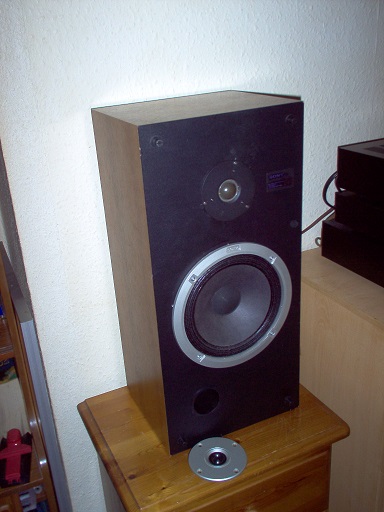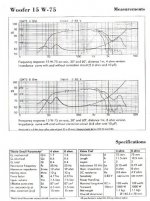I am new to speaker building, built have built a pair of Buschorns with FE83'S that sound quite nice. I wanted to build a small bookshelf this time around and really enjoyed the sound of the Model 1's. Deep Base is the least of my concern. I am looking to build a system that delivers the mid range/hi end clarity that the totems have. I also thought their sound stage was quite good. I would like to keep this project to around $200 for the drivers. Then whatever is needed for the crossover's and enclosure. I've nevered designed a X-over but can read schemetics.
Thanks for any help on this...Lee
Thanks for any help on this...Lee
Hello, I am pretty sure that no one has built a real Model I clone (or at least published it).
I am in the process to build the Totem Arro Clone. I am still designing it but I did not spend a lot of hours until now, anyway. It is really hard to find accurate information on a specific loudspeaker. I did a lot of research on the net, and I am lucky enough to read French language magazine published here. Since it is a local company, these magazines have published several articles on different Totem loudspeakers. When you bring all this information together, you have a good idea how the system is designed, but for sure, you will never obtain the same (Totem) personality.
The Arro Clone thread is here
I am in the process to build the Totem Arro Clone. I am still designing it but I did not spend a lot of hours until now, anyway. It is really hard to find accurate information on a specific loudspeaker. I did a lot of research on the net, and I am lucky enough to read French language magazine published here. Since it is a local company, these magazines have published several articles on different Totem loudspeakers. When you bring all this information together, you have a good idea how the system is designed, but for sure, you will never obtain the same (Totem) personality.
The Arro Clone thread is here
Member
Joined 2009
Paid Member
Problem is you can’t buy the Dynaudio base driver. This is key for mid high because the cone breakup of the woofer affects the performance higher up. The Dynaudio driver has a superb smooth roll off from what I remember seeing on the Dynaudio website.
By the way, I remember hearing the Totem, I thought it was superb. If you solve the driver choice problem I will also be interested. I don’t have a particular budget constraint.
By the way, I remember hearing the Totem, I thought it was superb. If you solve the driver choice problem I will also be interested. I don’t have a particular budget constraint.
Last edited:
The Totem Acoustic Model 1. Allegedly based on Native Americans dancing round a Totem Pole by the light of the silvery moon while hopped up on mind-expanding substances like Peyote. Really, are we supposed to take this stuff seriously? 
It's just a tiny bedroom speaker, IMO.
Totem Acoustic Model 1 loudspeaker Measurements | Stereophile.com
I've got the Dynaudio 15W-75 frequency response curve in my splendid archive of all things loudspeaker. 4 and 8 ohm versions below.
A 5" woofer with a surprising 3kHz natural rolloff.
Can't be too hard, can it? Bafflestep coil and impedance correction ought to work.
Something like this with a few adjustments. Peerless HDS PPB 830860
It's just a tiny bedroom speaker, IMO.
Totem Acoustic Model 1 loudspeaker Measurements | Stereophile.com
I've got the Dynaudio 15W-75 frequency response curve in my splendid archive of all things loudspeaker. 4 and 8 ohm versions below.
A 5" woofer with a surprising 3kHz natural rolloff.
Can't be too hard, can it? Bafflestep coil and impedance correction ought to work.
Something like this with a few adjustments. Peerless HDS PPB 830860
Attachments
Member
Joined 2009
Paid Member
Because SEAS and Scanspeak pursue a different direction IMO! 
Dynaudio and Morel design drivers with high mechanical damping and huge 3" voicecoils that needs little crossover effort to hit LR2.
SEAS and Scanspeak and lately, SB Acoustics, rely more on the electrical crossover to hit the target.
Which might be LR2, BW3 or LR4.
Nobody really knows the perfect speaker IMO. My own favourites have tiny 1" voicecoils and non-existent dustcaps:

Time will tell.
Dynaudio and Morel design drivers with high mechanical damping and huge 3" voicecoils that needs little crossover effort to hit LR2.
SEAS and Scanspeak and lately, SB Acoustics, rely more on the electrical crossover to hit the target.
Which might be LR2, BW3 or LR4.
Nobody really knows the perfect speaker IMO. My own favourites have tiny 1" voicecoils and non-existent dustcaps:
Time will tell.
Yep, big voicecoils can give high inductance which gets you a very smooth roll off at a low frequency, but it can increase distortion in the midrange and treble if not done right. It is better to try to minimise voicecoil inductance and create the needed roll off in the crossover. That is definitely that mindset that ScanSpeak and other modern manufacturers follow.
Member
Joined 2009
Paid Member
Unless someone here produces Arta REW or whatever home brewn measurements of the Dynauadio woofers that actually show the claimed smooth roll off, I simply do not buy the pretty-picture factory made measurements of Dynaudio.
Vance Dickason measured the 15W75 in Loudspeaker Recipes nr 1. His LMS measurements show a mild 2 dB peak at 1 kHz and then another sharp 3.5 dB peak at 3.9kHz, above which the output drops steeply, that is some 4th order, to resonate again with a 10 dB peak at 10 kHz. Level at 10 kHz is only 10 db below the passband, but is minus 20dB at 6-7 kHz. Generally speaking the 15W875 behaves well to 3 kHz, but above causes havoc.
So the actual roll off of the response of the 15W is not smooth at all. It rather seems the voice coils decouples from the cone above 4 kHz. This is certainly not what SS and Seas are after in their designs. I would be surprised if the 17W75 would be any different, but stand corrected in case it is.
Good Luck,
Eelco
Vance Dickason measured the 15W75 in Loudspeaker Recipes nr 1. His LMS measurements show a mild 2 dB peak at 1 kHz and then another sharp 3.5 dB peak at 3.9kHz, above which the output drops steeply, that is some 4th order, to resonate again with a 10 dB peak at 10 kHz. Level at 10 kHz is only 10 db below the passband, but is minus 20dB at 6-7 kHz. Generally speaking the 15W875 behaves well to 3 kHz, but above causes havoc.
So the actual roll off of the response of the 15W is not smooth at all. It rather seems the voice coils decouples from the cone above 4 kHz. This is certainly not what SS and Seas are after in their designs. I would be surprised if the 17W75 would be any different, but stand corrected in case it is.
Good Luck,
Eelco
- Status
- This old topic is closed. If you want to reopen this topic, contact a moderator using the "Report Post" button.
- Home
- Loudspeakers
- Multi-Way
- Has anyone built a Totem Model 1 Clone?
